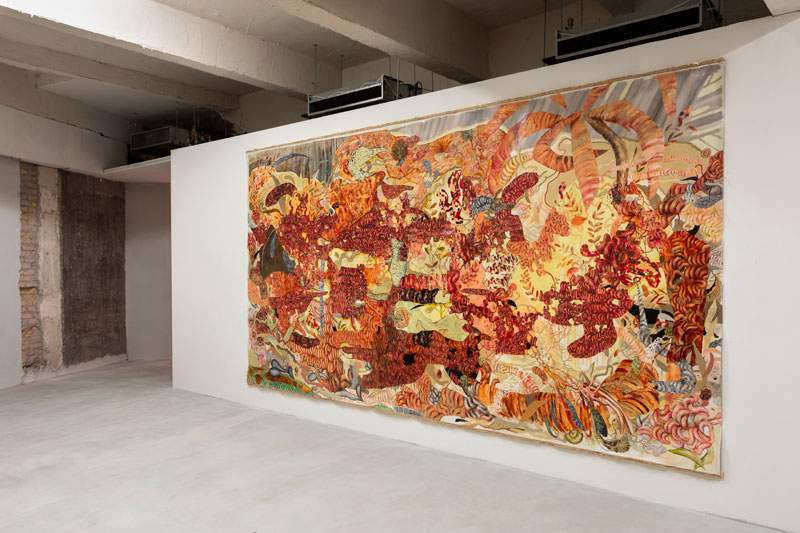Double exhibition at the Eduardo Secci Gallery in Florence, which hosts the solo shows of Marco Tirelli (Rome, 1956) and Radu Oreian (Tarnaveni, 1984), from January 23 to March 6, 2021, scheduled in the two areas of the Gallery in Piazza Carlo Goldoni 2 in the Tuscan capital. The solo exhibition of the Roman artist is curated by Alberto Fiz, while that of the Romanian sees the curatorship of Pier Paolo Pancotto.
As for Tinelli’s exhibition, on the occasion of this first show in the Florentine gallery space, the artist presents a series of unpublished works created during the lockdown months. The works are offered in three spaces through an arrangement aimed at creating a strong emotional involvement. The exhibition, in fact, gives rise to a crescendo that leads up to an installation of about 12 frameless canvases of different sizes arranged on the wall. Thus conceived, the latter is characterized by a parallelism with the large-scale project that Tirelli created for the 2013 Venice Biennale.
In this latest cycle of works, Tirelli questions the regenerative power of the image based on an investigation that seems particularly relevant in today’s society, where the media flow seems to have subtracted value from every form of iconography by trivializing the message. Tirelli, on the contrary, recovers the primary meaning of the image by subjecting it each time to the verification of painting, which does not duplicate reality but transforms it.
As curator Alberto Fiz explains, “Tirelli creates a laboratory of the image and the imaginary without any hierarchy that stems from the desire to recover the essence of the visible.” His repertoire is vast and includes symbols, naturalistic elements, bodies, geographic maps, objects for observing space, fragments of the sky based on a continuous work in progress where the subject is functional to a process of physical and mental reappropriation. “Painting is the tool that allows me to bring ideas back to the concreteness of the hand,” says Tirelli, who questions the very material of which the images are made. As part of the exhibition, the succession of his works allows the visitor to return to the fascination of continuous rediscoveries with respect to a real that finally returns to being perceived.
Marco Tirelli was born in Rome in 1956 and currently lives and works between Rome and Spoleto. He is a member of the Accademia Nazionale di San Luca and the Accademia dei Virtuosi del Pantheon. Tirelli attended the Academy of Fine Arts in Rome where he graduated in Scenography with Toti Scialoja. He has exhibited in solo shows at the Macro in Rome, the Palazzo Fortuny Museum in Venice, the MAMC in Saint-Etienne, the Peschiera Foundation in Pesaro, and several group shows, including three editions of the Venice Biennale.
As for Radu Oreian’s exhibition, this is the Romanian artist’s first show in Florence. The body of work on display represents a selection of the artist’s latest works, a series ranging from graphite drawings to oil paintings on canvas, wood and plexiglass. This variety of media, in addition to reflecting the ease with which Oreian moves between different techniques, is also evidence of the classical heritage that seems to be at the root of the artist’s practice. The oil paintings, made especially for the exhibition and dated 2020, are part of the cycle of so-called Molecular Paintings. They are works that resemble miniatures with minute details, capable of capturing the viewer’s eye and transporting it across the paint-soaked surface and leading it to the deeper meaning of the painting.
As Pier Paolo Pancotto writes in his introductory text, what unites Oreian’s works “despite their heterogeneity, is a dense, strongly expressive chromatic vocabulary where the material seems at times to clump and amalgamate with other substances until it becomes rough, sandy even if, in reality, it is only the way in which it is arranged on the plane (layered and kneaded at the tip of the brush) that causes this effect; as well as, a shared iconographic repertoire, ranging from the physical memory (the call to the bowels of one’s body or skin) to the intellectual memory (Renaissance painting, classical painting admired in Pompeii and Rome, the calligraphy of the ancient Orient) of the artist.” Radu Oreian’s practice draws from the classical techniques of drawing and painting, exploring how history, ancient myths and archives shape our society and our understanding of humanity. The red thread that runs through and unites Radu Oreian’s works manifests itself in the creation of a new meditative visual imprint endowed with a particular density that seems to exist in a pulsating state of tension and relaxation.
Radu Oreian was born in 1984 in Târnăveni, Romania. He currently works and lives in France. In 2002 he obtained a degree from the University of Art and Design in Cluj-Napoca and then continued his studies at the National University of Art in Bucharest where he graduated in 2007. He has exhibited not only in his native country but also in Italy, France, the United Kingdom, India, and the Czech Republic.
For all information you can visit the official website of the Eduardo Secci Gallery.
Pictured: one of Radu Oreian’s paintings.
 |
| Florence, double exhibition at Eduardo Secci Gallery: Marco Tirelli and Radu Oreian |
Warning: the translation into English of the original Italian article was created using automatic tools. We undertake to review all articles, but we do not guarantee the total absence of inaccuracies in the translation due to the program. You can find the original by clicking on the ITA button. If you find any mistake,please contact us.